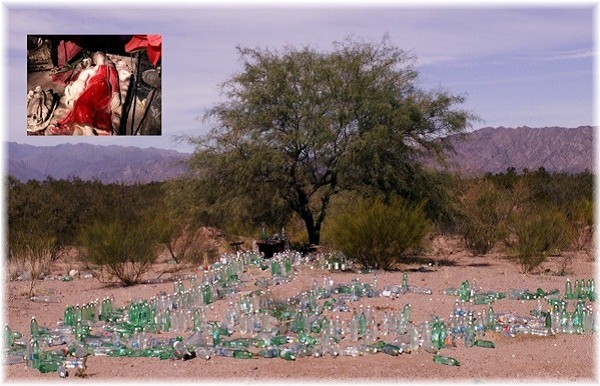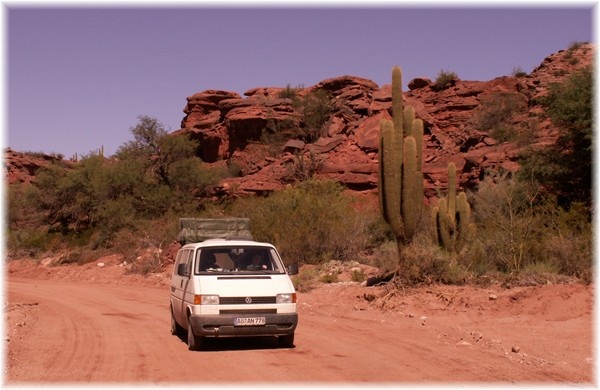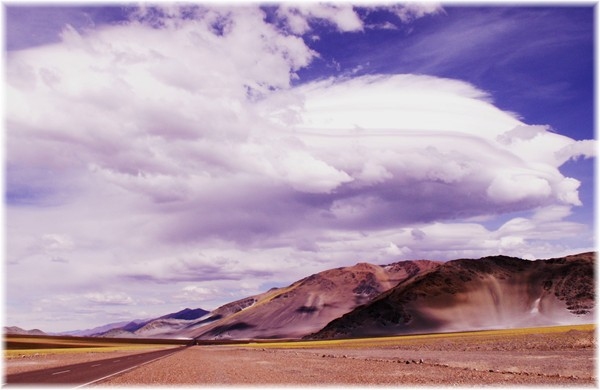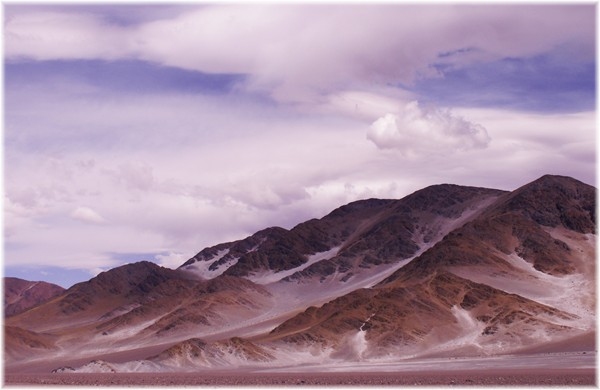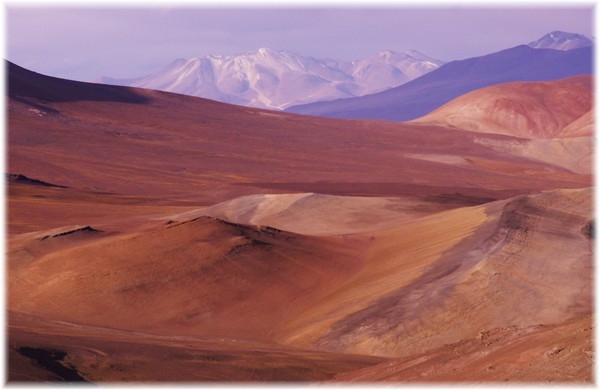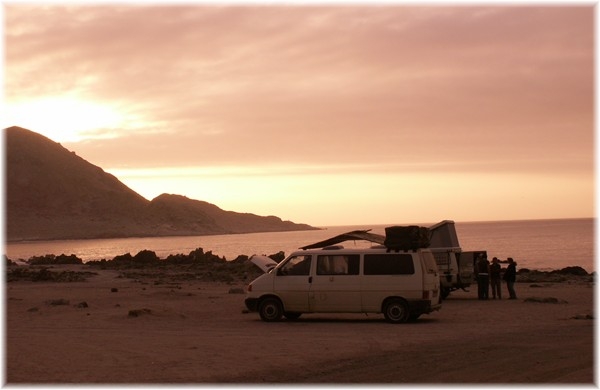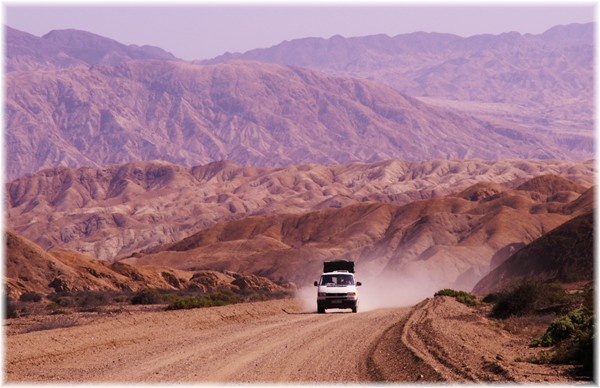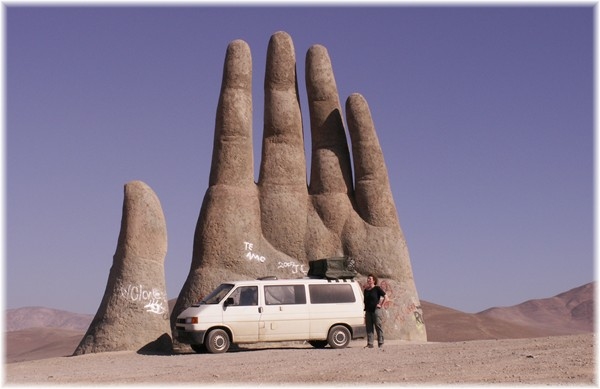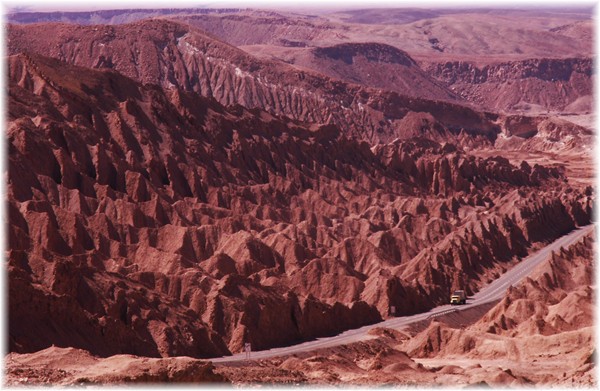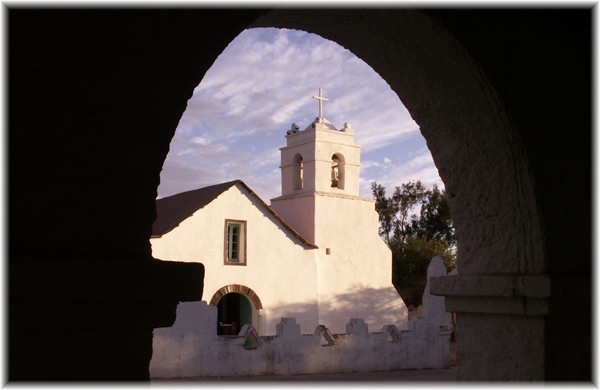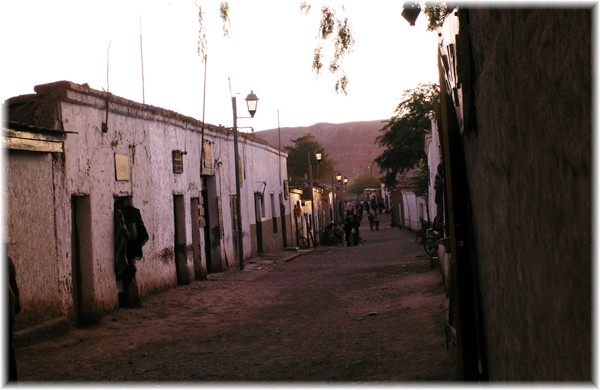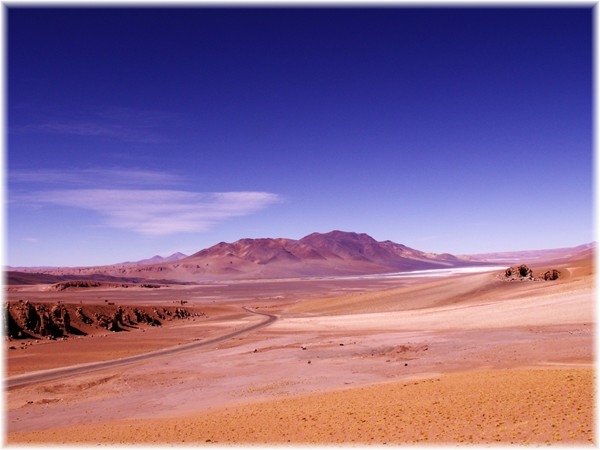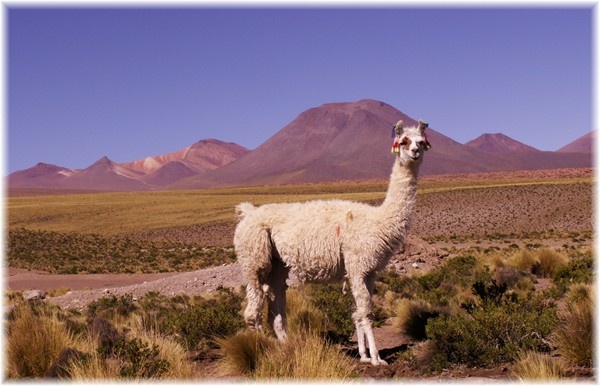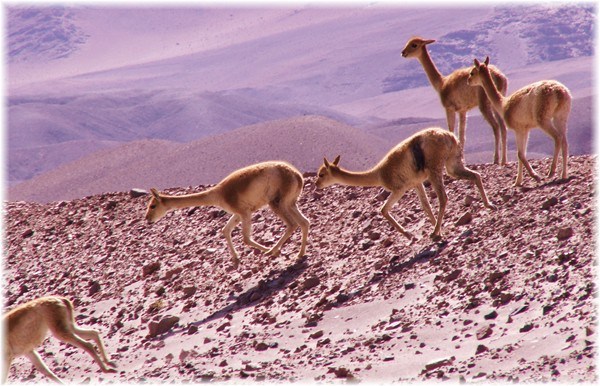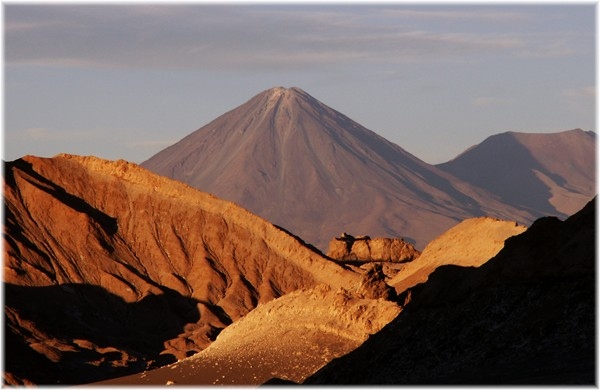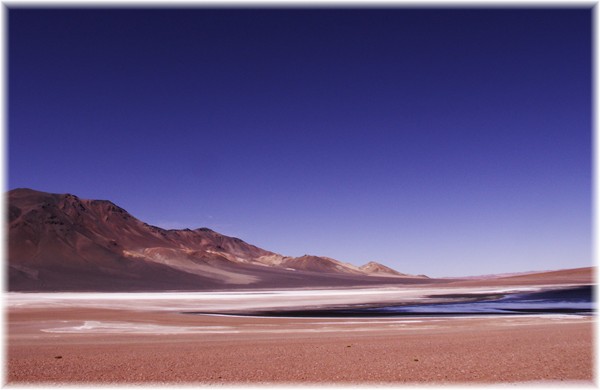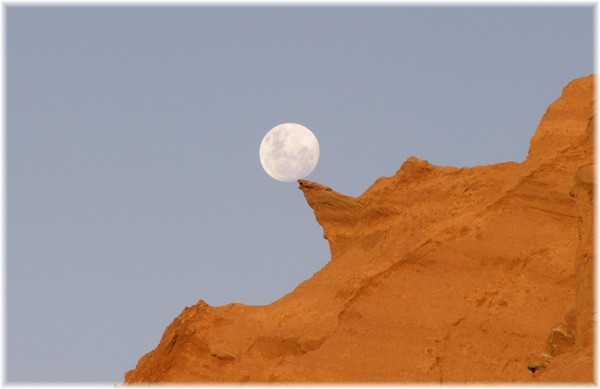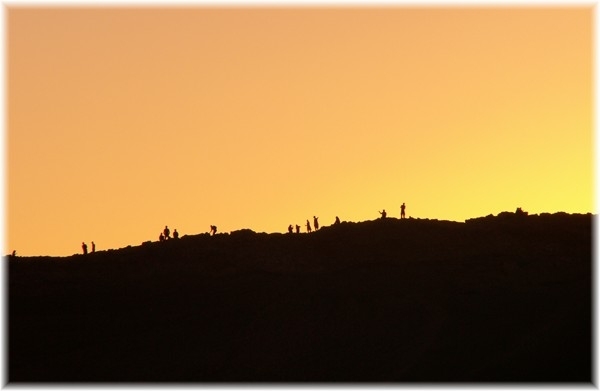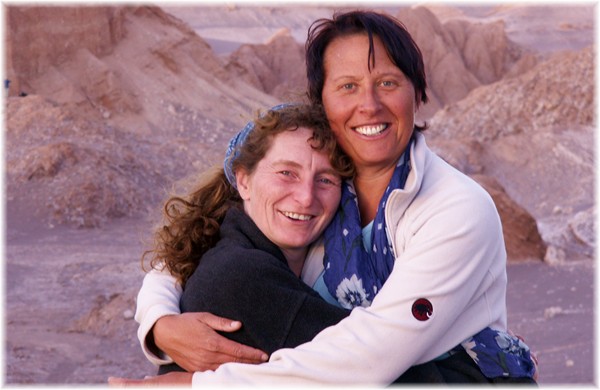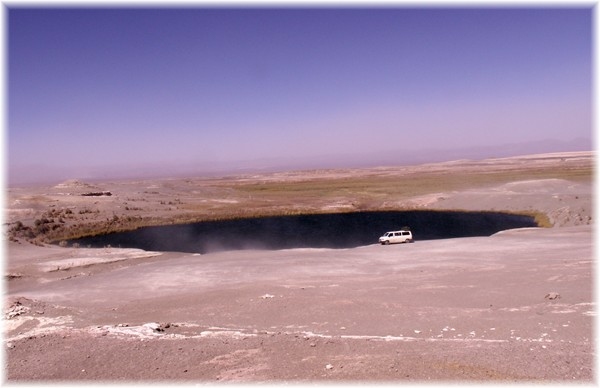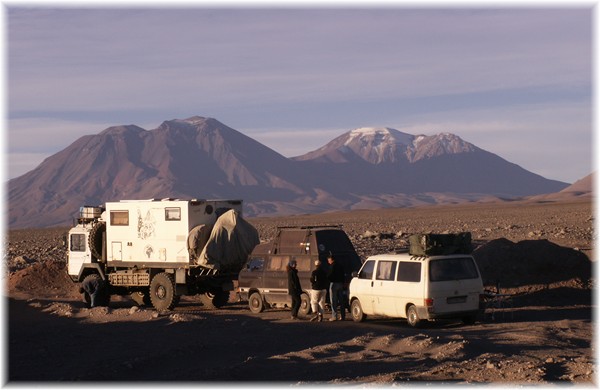On the other side of the street there are lots of plastic bottles which are filled with water. This time we stop there, since we have seen this already quiet often. Till now we always thought this is just rubbish lying on the street. Well this time we will have a closer look and we can realise that behind the bottles there is a kind of altar , with a woman lying on her back having a little baby on her breast. We don´t know what the meaning of this is and ask Jorge, who have a kiosk in the next village, what is it all about. He tells us the story of Deolinda Correa, which have happened in the year 1841. Deolinda Correa was a very brave women, which did walk through the desert just before getting the baby, to search for her husband, which she wanted to free from the armies. But right after given birth she died because of thirst. The child however survived, since the breast of Deolinda Correa still had milk. Lying on her back, with one bare breast, on her body lying the little baby, that’s how two Gauchos found her. Every year at Easter time there is a pilgrimage of over 50 000 people to the place where it is told that she have been found. The so called Difunta ( span= the dead one) is a popular saint in Argentina, even if the church do not accept her as this. Who ever believe in her will see another wonder. There are lot´s and lot´s of wonders which is said, that it was done by the Difunta Correa.
She is as well the patron saint of the truck driver. Down from Tierra del Fuego up till the Bolivian border you can see this altars. One time people started to leave water there, that no travellers should die having not enough water with them like the Difunta. In former times you could really drink that water, nowadays the bottles stay there till maybe one time somebody would recycle them. We as well have a cold drink at Jorges kiosk before we continue our drive on this hot day. We are again driving on the cuarenta. The broken Asphalt is melting and mixes with the red soil. We drive through fantastic looking country with thousands of cactus. In the rear mirror we can see how much dust is behind our car. Well we wanted to have more sunny and warmer weather but we did not think that it will get this hot. We sit in our car and feel like in a sauna. we do not visit the Valle de la Luna and the well known Talampaya Canyon since it would be to much. Too many wonderful, fantastic, magic nature we have seen, our heart and eyes needs a kind of break. We drive further on with many cactus along the street through the canyon Cuesta de Miranda with it´s 800 curves till we reach Chilecito, Santa Florentina where we go this time on a campground.
New day, new luck. What would fit better to a hot day then the hot springs of Fiambala. So off we go to Fiambala which is 260 km far away. The springs are situated about 15 km east of Fiambala in a canyon 1800 m above sea level. 12 thermal springs are here one under the other in the middle od old trees which give enough shadow, that you are not feeling to hot. In the top basin the water comes out from the rocks with a temperature of 44 degrees Celsius. Through a waterfall it runs down to the next basin where the temperature is already one degree less and so on. So you have 12 basins where each of them have a different temperature. It starts to get dark and most of the people are going home, which had been here just for a day. Only a few are staying in the cabanas, which are situated next to the thermal springs. We get to know two man coming from Hamburg, with whom we stay till 1.00 am in the wonderful warm water, looking up to a marvellous sky with thousands of stars. Next day we wake up from a loud noise. The parking lot where we parked our car did become a construction site and therefore we drive as fast as we can away from here – without having breakfast. Short-term we decide to do our second passing of the Anden over the so called San Francisco Pass back to Chile. This time we are much better prepared, since we were most of the time at a height of around 2000 m. Therefore it should be not a bigger problem. The pass is at a height of 4748 m above sea level. We get first some more petrol, till we drive up the pass since the next petrol station is just to be found after 580 km in the city of Copiapo. The landscape we are driving through is just marvellous.
The San Francisco-Pass is really colourful, the colour of the rocks are changing every few minutes. The only animals we see here are wild donkey. On the Argentinean Pass the street is just asphalt. So higher we come so less oxygen is in the air. For a few moments Michaela´s heart is throbbing. But she feels better very soon and anyhow, every 10 km there are small hats with the first aid kid and oxygen masks.
The Argentinean border control is at a height of 4000 m. The two people from Hamburg, which we met yesterday at the thermal springs are already coming back from the pass. They started quiet early this day since their goal was just to go up and coming back in the evening to the thermal springs to relax in them again.
Now we are nearly at the very top of the pass on 4748 m and this is as well the actual border of Chile and Argentina. On the Chilenian side there are just gravel roads. We pass at a Laguna where there are two natural thermal springs and therefore we make a short stop, to dip our feet’s into this warm water. After that we drive for hours through a plateau.
Around us the mountains are looking really majestic. All peaks which we see here are over 6000 m. We pass the salt lake of Maricunga where the border control of Chile is situated. Two young quiet bored border officer await us. Certainly Michaela has hidden again all our vegetables and fruits in the best way she does it always – that’s what we thought. Again the question: “Do you carry any milk products, meat, fruits or vegetables with you?” In the same moment Michaela is saying: “Sure not” a tomato rolls out the cupboard which one of the border officer has opened. He takes it with humour and all four of us are laughing about that. The tomato he still keep´s. Before we continue driving further we have a nice chat with a packet of Haribo gum bears, which we bought in La Serena in a supermarket. This gum bears of Haribo are very seldom to be found in South America.
Finally the road takes us now down direction Copiapo. 180 km nothing than just desert, only a few km before Copiapo we can see some very small villages. It is already dark when we reach the city, therefore we decide to overnight at a petrol station. Next day we drive further north on the Pan-Americana. We are already at the southern foothill of the Atacama desert, one of the most driest and hottest deserts on earth. In some parts it have not rained for the last 100 years. At Chanaral we go direction the sea where there is a small national park called “Pan de Azucar”, which means sugar loaf.
The peculiarity of this national park are the cactus, there are twenty different ones here to be found. The second peculiarity is – at least for us: Ingo, Joli and Reni are as well overnighting there with their car. We have a wonderful evening together and next day we do go further on the Pan-Americana while the trio is still taking another day in the national park.
About 1000 km long is the Pan Americana going through the Atacama desert. It is Sunday and just a few cars are on the road. Mostly trucks which are on their way back to the South. They deliver goods into the sparsely settled North of Chile. Wherever we look there is just desert till the horizon in all different shades of brown. In the far distance we can already see a bigger city that must be Antofagasta. One of the few bigger cities in the north. As we come nearer to it, we recognise this were just knee-high bushes. It was a Fata Morgana, which happens through the heat. Later in the afternoon, finally a cool breeze is coming from the ocean and we are sure know that we must be near Antofagasta
300 000 inhabitants are living in Antofagasta along the coast for about 15 km. Since the price for copper has been rising on the world market, the town at the edge of the Atacama booms. There are lots of copper mines in the hinterland and the copper is transported from there to Antofagasta where it is brought on ships from where they are transported all over the world. We drive along the coast till Tocopilla then pass Calama direction to the desert village of San Pedro de Atacama. There are still 200 km to go. On our way there we pick up Ramon who had a breakdown with his car. The road gets very steep now. To steep and that’s why after another few kilometre we have to stop. The temperature of the cooling water did rise. So we have to wait together with Roman till the water cools down again. Actually we don’t know why it happened because both ventilations are running properly and it was enough water in it. Could it be that it is all because of the thin air here up in 3000 m height? Well after half an hour the engine cooled down again and we can go further. After a few kilometres we are at the top of the hill and from now on it is going downwards. While we are driving, Ramon tells us that he is working in the world biggest copper mining in Chuquicamata which we pass on our way. In Calama he leaves us to get somebody to pick up his car. But before that he gives us his telephone number and invites us to his home which is about 100 km far from Calama. We will tell more later about that. Shortly before San Pedro we are stopping on the side of the street, to look down to the valley where there is San Pedro de Atacama and as well the Salt lake in the South. We just see a green Oases with trees and bushes, no houses, nothing. The peculiarity of the Oases is the low way of building houses which are mostly done out of loam and wood of the cactus. None of the houses are bigger then one floor (apart from the house where the police is situated) and therefore all the trees are bigger and you have the feeling when you look from a far distance that there are no houses at all.
16 years ago I have been already in San Pedro de Atacama and I was feared that the village through tourism would have changed a lot. But I have to say, God thanks, it haven’t changed much and the village still has it´s flair. Certainly there is a lot of tourism and therefore lots of the houses which at that time have been homes have changed into souvenir shops, restaurants and travel agencies. Nevertheless it is charming to walk through the lanes with the loam on the street and the limed houses. One of the very few sightseeing spots is the church, called „ Iglesia de San Pedro“ from the 18th century with a roof made out of cactus wood.
Our residence for the next days is the Hotel-Camping Takha Takha in the middle of the village where there is a blooming hollyhock garden. This is a good base for the tours we want to make into the surrounding of San Pedro and on top of it, it is just two minutes away from the pedestrian zone of the village.
We have made up an appointment with our Swiss friends Joli, Reni and Ingo which are arriving two days later. There are some reparation to be done on the cars as well the washing and some emails and so on. We cook together and certainly there is lots to talk about. Michaela, Reni and I are doing a daytrip up to the Jama Pass on a height of 4400 m.
San Pedro is ideal to acclimate, since this desert village it is on a height of 2500 m. That’s why we nearly don’t realize the 2000 m more on height. First the street is constantly going up and then we are on a plateau where we watch Lamas and Alpacas, which are owned by the Indio families.
Other than the small houses made out of loam and the herds, the families do not own anything else. Lamas and Alpacas are belonging to the family of the camels, that’s why they are called Andean-Camels. There are two more species of camels which are living up here on the Altiplano. The wild and very shy Guanacos and the Vicuñas. Both are more looking like a dear then a camel. The wool is said to be the nicest and finest of the world. That’s why in the 1970th there were just about 1000 of the Vicuñas left. Just in time they have been added to the protection of species and therefore over 27 000 Vicuñas are living here again.
Well that’s for the world of animals.
We drive further through the plateau. To our left-hand there is the Bolivian volcano Licancabur with a peak of 5930 m. At my first visit to South America I wanted to climb up this perfect looking volcano together with another Bavarian which I met in San Pedro. Just about 300 m before the peak we had to return, because we were exhausted. Today I admire the magic of the volcano from a far distance.
We drive through inhospitable landscape. Saltplateaus are mainly here in this picture of landscape. One time the landscape looks wide and smooth and then it looks quiet bizarre. As we drive back again the landscape is different out of the light from the afternoon. The plateaus are touched by long shadows from the mountain range.
Half an hour before sunset we are back at San Pedro. The highlight of the day is still to come. Not far from San Pedro is the „Valle de la Luna“ (the valley of the moon). A street is leading us through this “Moon landscape”. We have just two days before the full moon and so we are really lucky. The moon is nearly round.
In the same moment on one side the sun is saying good bye and the desert is touched in all different colours, the moon is making his way up. The light changes minute by minute. Some buses full with tourists are already at the parking lot at the big sand dune. About 80 “Picture hunter” are storming up to the dune and taking one picture after another.
Certainly we do the same, just from another hill. Unfortunately the light spectacle in this clear air lasts not long and the last buses already leave the “Moon valley”. Silence is back here where just the moon is awake and take care over his valley.
Ingo and Joli did already await us since we still want to cook together. At dinner we go over the day and the fantastic things which we have seen today. The evenings out in the deserts are cold so we cant sit to long outside and go back into our warm cars. We had planned just a few days staying here, but in the end we stayed 8 days in San Pedro de Atacama. Reni´s vacation is coming to an end and Ingo and Joli are bringing her down to Calama where her flight is going back to Switzerland.
We still have our date with Roman, which we picked up the other day on the way to Calama. This meeting unfortunately never happened, why we don’t know, maybe a misunderstanding. We have been at the meeting point but he never showed up, so we just could leave a message on his answering machine.
In Calama, on the municipal camping we meet Gudrun and Volkmar from Berlin which are as well travelling with a VW Bus. Next to them there are Marion and Walter from the Ruhr area travelling with a MAN Truck. We all have the same destination which is BOLIVIA. We drive all on the same day towards Bolivia but not at the same time since all of us have a few things to do in town. But we decide, that we will meet each other on the way at about 3000 m to get the body acclimated again since next day we go over a pass with a height of over 4000 m. Michaela and I are visiting a small village along the road called Chiu Chiu. Actually we want to visit a small lagoon which is called „Inca Coya“. Well it looks more like a round waterhole in the middle of the desert and nobody knows how deep it is. Even the very famous French biologist for ocean, Jacques Cousteau has been here, trying to find out how deep it is. His divers couldn’t go further then 2000 m and it was still not the ground of the hole.
We drive from the hole with unknown depth further direction Bolivia. In the late afternoon we see already both cars in the far distance and join them. We just have enough time to drink a cup of coffee together, then all of us are going back to the car since it is to cold to sit outside. In the night we have – 12 degrees Celsius.
Well that’s enough for today, we are near the Bolivian border. The next report will be already from Bolivia
Michaela and Raimund

